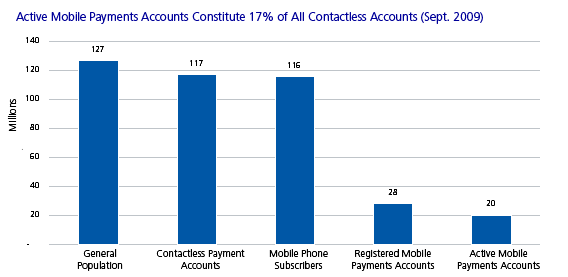Lessons from the Mobile Payments Leader: What the World Can Learn from the Japanese Market
Abstract
The Japanese mobile payments experience is not easy to characterize or to export. However, using the Japanese model, Celent identifies ways for the US and other countries to learn how to lay the groundwork for faster, more successful implementations of mobile NFC payment solutions.
Within industry pundits' persistent predictions about the imminent advent of mobile near-field communication (NFC) contactless payments, the Japanese market is frequently cited as proof that such payments have a future. However, Japanese market reality is not as much of a straightforward success as many believe. Based on primary research with leading mobile carriers, banks, payment services/brands, and technology vendors, Celent estimates that there are 28 million registered mobile payments accounts in Japan. Furthermore, Celent estimates that there are about 20 million active mobile payments accounts. Respectively, these constitute 24% and 17% of all contactless payment accounts.
Japanese ecosystem differences must be considered when applying its lessons abroad. However, there are a number of lessons from Japan which transcend market ecosystems, and they are explored in a new report, Lessons from the Mobile Payments Leader: What the World Can Learn from the Japanese Market. In brief, these include the following:
- Consumer adoption takes time, even among a tech-savvy population.
- For consumers, the actual payment (i.e., financial settlement) component of mobile payments is irrelevant; incentives are what matter above all.
- Merchants feel the same as consumers; financial settlement matters little, whereas the ability to leverage mobile technology for promotions and sales lift is crucial.
- Mobile contactless payment technology opens new business opportunties and thus invites new market entrants; Japan shows that non-FI disintermediation in the payments space is a real threat.
- Inter- and intra-industry collaboration is a key success factor. As different industries play a crucial role in mobile contactless payments, no one industry can expect to go it alone.
- The jury is out regarding whether banks can make (incremental) money from mobile contactless payments. Debit cards as foundational sources of funds have yet to be used in Japan.

“Although Japan obviously differs from the rest of the world, its success in the mobile contactless payments space merits examination,” says Red Gillen, Senior Analyst with Celent’s Banking Group and author of the report. “If one puts aside the technical and infrastructure differences of the Japanese market, there are a number of empirical, strategic business lessons that are relevant to other countries.”
This report is of special interest to the US and other markets, where dominant mobile payments players have yet to emerge, and alliances are still formulating. In Japan, the largest mobile payment services are the domain of non-FIs, such as mobile carriers, merchants, and third party payment solutions; banks and international payment brands play distant if barely existent roles. The Japanese experience has shown that non-FIs with US analogs such as PayPal, Apple, Verizon, AT&T, and even merchants including Starbucks or Wal-Mart have the potential to usurp the traditional financial services industry.

